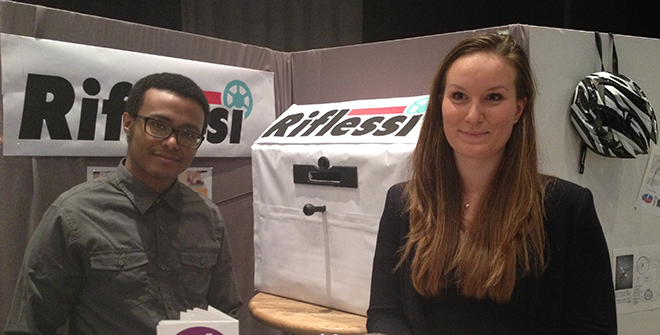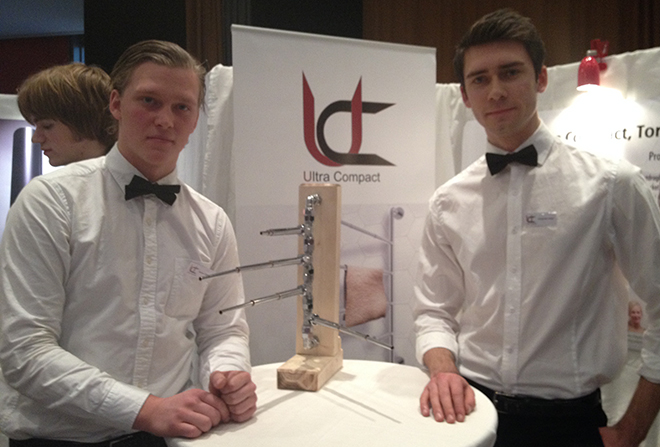Students showed their creative flair at the DoPexpo fair
Practical bicycle reflexes, a compact drying rack and electricity generating ski poles – those were some of the innovations that were presented at the DoPexpo fair at the students's union building Nymble at the beginning of December, when students from the master of science in engineering programme Design and Product Development exhibited their newly developed innovations.
Reflex spokes

Linn Rilegård, Seid Saleh and their course group mates have produced reflex spokes under the product name Riflessi. The theme for their innovation was sports bicycle.
"Most traffic accidents are related to bicycles. At the same time, today's bicycle reflexes are often bulky and risk coming off from the wheels or break. With Riflessi the weight of the reflexes decreases and at the same time they cover a large area when the wheels rotate", explains Linn Rilegård.
The group that has developed Riflessi consists of eight people and Seid Saleh argues that being so many people working together has facilitated the work.
"You can't do everything yourself", he adds.
The reflex spokes appear to be s simple solution to the difficulties associated with traditional bicycle reflexes. And as Swedish law prohibits cycling without reflexes on the wheels, there is a clear need for the innovation.
The group worked simultaneously on several ideas and decided quite late in the around two month long process to choose the reflex spokes.
"Partly, it was because this particular idea was the easiest to develop", says Seid Saleh.
Torken - a drying rack

Christoffer Bator, Gustav Sandström and their course group mates focused on the compact living theme.
"It is quite a broad theme and you are relatively free to interpret it yourself", explains Gustav Sandström.
The group developed the product Torken: a collapsible, wall mounted drying rack. When you want to dry laundry the rods can be turned outward and can also be extended to accommodate a maximum amount of laundry. And when it is not used it is possible to pull back the rods and turn then inward towards the wall again.
"The problem with many traditional drying racks is that they often stick out and take up a lot of space", explains Christoffer Bator.
The group were able to look at the report from the previous year's student group working on compact living, a group that focused on recycling. In this way, they could gain some guidance in their work.
"The instructions for these types of projects are not always crystal clear", says Gustav Sandström.
The group worked on three different concepts during a longer period of time before deciding on focusing specifically on the drying rack Torken.
The course has proven instructive in many ways for the students. They have had to study manufacturing processes, they have learned to use CAD drawing software and have studied sustainability. And another skill they have had to develop is to make quick sketches.
"You have to be able to sit down and make sketches of ideas together with clients fairly quickly if you are to gain a foot in the door and attract new clients", explains Gustav Sandström.
Little North Pole - the electricity generating skiing pole

For Jenny Frost, Petter Erlandsson and their course group mates, the focus was mountain hiking. Their innovation, the electricity generating cross country skiing pole Little North Pole, is both a word play and an exercise of creative technical design.
"North Pole can refer to Nordpol which is the name of the largest electricity supplier in the Nordic region. A the same time the Swedish word skidstav is called ski pole in English", Petter Erlandsson tells.
Little North Pole is made out of such diverse parts as a spinning top, plastic tubes, springs, drawing pins, magnets and copper wire. It generates electricity when pressed into the ground at every pushoff by the pole.
"Initially, we thought of making a walking pole, given the mountain hiking theme, but then we realised that you can generate more electricity through the pushoff of a ski pole when doing cross country skiing than through the walking pole", explains Jenny Frost.
The aim is to place the parts for producing electricity in the handle of the pole. This enables users to switch handles and bring the electricity generating functionality to new skiing poles.
"We had several different ideas that we worked on initially, such as inflatable tents, trail poles along hiking trails and different navigation systems. But finally we ended up developing this", tells Jenny Frost.
The combination of spinning tops, plastic tubes, springs, drawing pins, magnets and copper wire sounds very innovative, but Petter Erlandsson explains it was in fact the result of a lack of money that forced the group to find design parts at jumble sales. However, the group sees the potential of producing a considerable amount of electricity with the help of the Little North Pole, electricity that can be used to charge a mobile phone battery among other things.
Second and third year students
While first year students worked on themes such as sports bicycles, travel, safety, compact living and mountain hiking, second year students developed products measuring time for people with reduced cognitive capacity, commissioned by the Swedish Institute of Assistive Technology (Hjälpmedelsinstitutet) in collaboration with Abilia. Watches and devices for showing the date may seem difficult to develop further. But the product Birdbuddy not only keeps track of the date, day of the week and time of the day – it also provides the information by auditive means when a sound button on the Birdbuddy device is pressed. And the product Minna connects a calendar to a watch like object, reminding the user when it is time to carry out a planned activity.
Third year students had been given the task of developing different 3D printers for the consumer market. With names such as Älvan (The Fairy), Kalas (Party), Octagon and Plumbum (nonsense word) they showed how slick design can be combined with distinct functionality. For certain varieties, such as Creative Box, the product (or at least the software) was adjustable according to age and level of complexity. And the product FreeDPrint provides the user with the opportunity to print 3D objects not only from data material but also from free form instructions.
For more information, see: dopexpo.com
Text and photos: Emma Bayne

